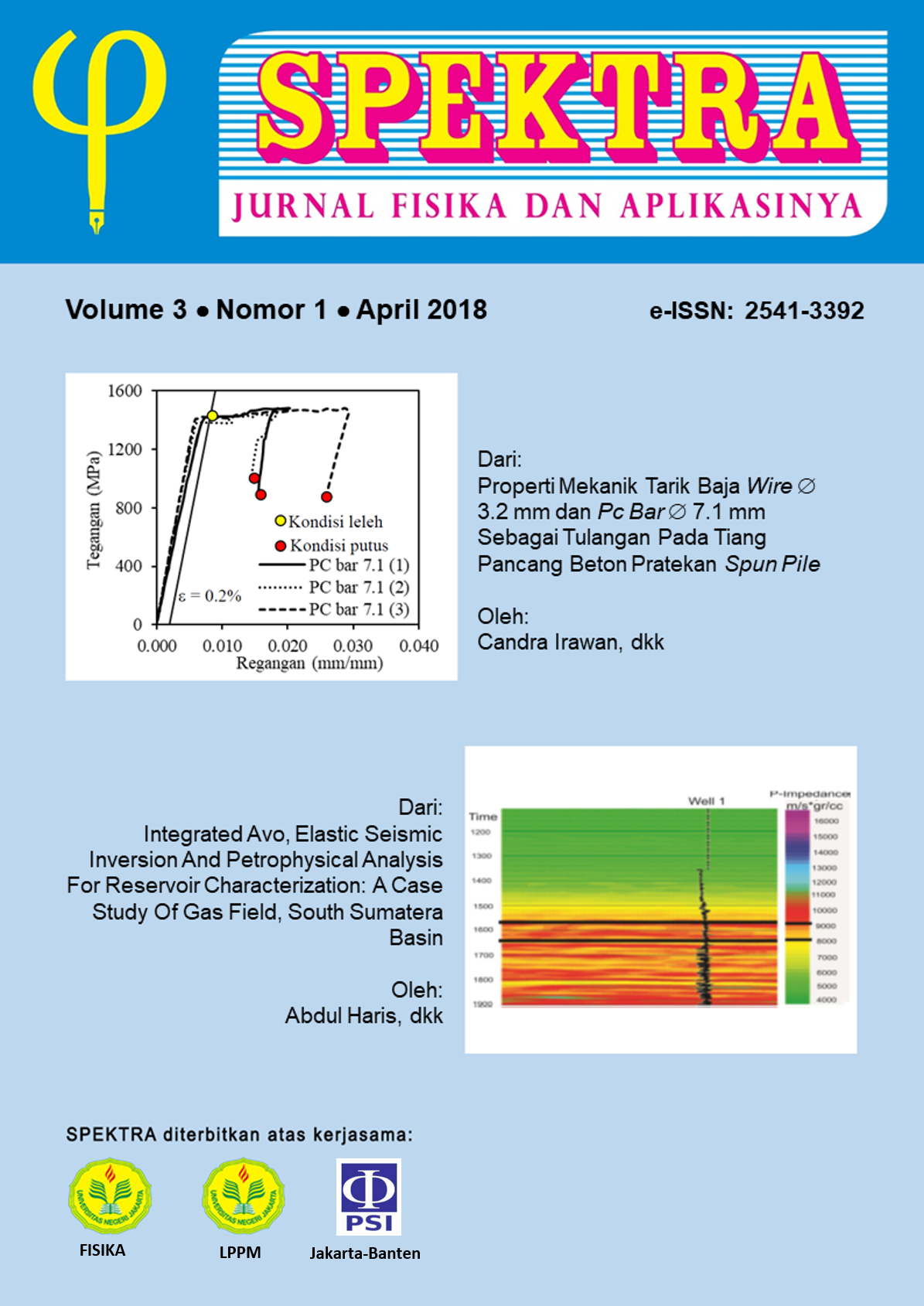ANALYSIS OF THE INFLUENCE OF GOLD NANOPARTICLE ADDITION TO PHOTOLUMINESCENCE EMISSION INTENSITY AND DECAY TIME OF 618-CDSE QUANTUM DOTS
DOI:
https://doi.org/10.21009/SPEKTRA.031.04Keywords:
gold nanoparticles, quantum dots, photolumiescenceAbstract
Abstrak
Telah dilakukan pencampuran nanopartikel emas dengan kuantum dot CdSe 618. Tujuan dari penelitian ini adalah untuk mengetahui pengaruh penambahan nanopartikel emas terhadap intensitas emisi dan waktu peluruhan fotoluminesensi kuantum dot CdSe 618. Dalam 2 mL kuantum dot CdSe 618, ditambahkan nanopartikel emas sebanyak 40 µL, 80 µL, dan 120 µL. Pada setiap penambahan tersebut, dilakukan pengujian fotoluminesensi dan time-resolved photoluminescence, masing-masing untuk mengetahui intensitas emisi dan waktu peluruhan fotoluminesensi kuantum dot CdSe 618 setelah ditambahkan dengan nanopartikel emas. Dilakukan pula pengukuran terhadap rentang panjang gelombang absorpsi dari nanopartikel emas, beserta ukuran diameter partikel-partikelnya. Hasil pengujian menunjukkan bahwa secara keseluruhan, intensitas emisi kuantum dot CdSe 618 setelah ditambahkan dengan nanopartikel emas menjadi lebih rendah, dan nilai waktu peluruhan fotoluminesensi menjadi lebih besar. Penurunan intensitas emisi dan peningkatan waktu peluruhan fotoluminesensi diakibatkan oleh kemunculan plasmon pada nanopartikel emas.
Kata-kata kunci: nanopartikel emas, kuantum dot, fotoluminesensi.
Abstract
We have done the mixing of gold nanoparticles and CdSe 618 quantum dots. The purpose of this study is to see the influence of gold nanoparticles increment to emission intensity and photoluminescence decay time of CdSe 618 quantum dots. Into 2 mL of CdSe 618 quantum dots, we added gold nanoparticles as much as 40 µL, 80 µL, and 120 µL. At each adding, we did photoluminescence and time-resolved photoluminescence testings, to see emission intensity and photoluminescence time decay of CdSe 618 quantum dots after the adding of gold nanoparticles. We also did a measurement of absorption wavelength range of gold nanoparticles, along with diameter size of the particles. The results showed that, overall, the emission intensity of CdSe 618 quantum dots became lower after the adding of gold nanoparticles, and the value of photoluminescence decay time became bigger. The decrease of emission intensity and the increment of photoluminescence decay time were caused by the appearance of a plasmon at gold nanoparticles.
Keywords: gold nanoparticles, quantum dots, photoluminescence.
References
[2] E. S. Shibu et al., “Photoluminescence of CdSe and CdSe/ZnS Quantum Dots: Modifications for Making the Invisible Visible at Ensemble and Single-Molecule Levels,†Coordination Chemistry Reviews, 2013. http://dx.doi.org/10.1016/j.ccr.2013.10.014
[3] Isnaeni and N. Yulianto, “Pengaruh Nanopartikel Emas terhadap Peningkatan Emisi Cahaya Kuantum Dot,†Spektra: Jurnal Fisika dan Aplikasinya, vol. 16, pp. 45-49, Dec 2015.
[4] Isnaeni, “Pengaruh Sumber Eksitasi LED Biru terhadap Efisiensi Kuantum Nanopartikel Luminesensi,†Telaah, vol. 32, pp. 39-46, 2014.
[5] U. Resch-Genger and K. Rurack, “Determination of the Photoluminescence Quantum Yield of Dilute Dye Solutions (IUPAC Technical Report),†Pure Appl. Chemistry, vol. 85, pp. 2005-2026, Sep. 2013.
[6] S. Leyre et al., “Absolute Determination of Photoluminescence Quantum Efficiency Using An Integrating Sphere Setup,†Review of Scientific Instruments, vol. 85, pp. 123115-123115, Dec. 2014.
[7] D. Sarid and W. Challener, “Localized Surface Plasmons,†in Modern Introduction to Surface Plasmons: Theory, Mathematica Modeling, and Applications. New York: Cambridge Univ. Press, 2010, pp. 201-255.
[8] S. Jie et al., “Time Decay Behavior of Fullerene-C60 Studied by Time-Resolved Photoluminescence,†Acta Physica Sinica (Overseas Edition), vol. 4, pp. 175-182, July 1995.
[9] D. R. Bell et al., “Concentration-Dependent Binding of CdSe Quantum Dots on the SH3 Domain,†Nanoscale, vol. 10, pp. 351-358, Nov. 2017.
[10] K. Surana et al., “Synthesis, Characterization and Application of CdSe Quantum Dots,â€J. Industrial and Engineering Chemistry, vol. 20, pp. 4188-4193, Nov. 2014.
[11] M. A. Hegazy and A. M. A. El-Hameed, “Characterization of CdSe-Nanocrystals Used in Semiconductors for Aerospace Applications: Production and Optical Properties,†NRIAG J. Astronomy and Geophysics, vol. 3, pp. 82-87, June 2014.
[12] M. J. Almendral-Parra et al., “A Novel Approach to the Fabrication of CdSe Quantum Dots in Aqueous Solution: Procedure for Controlling Size, Fluorescence Intensity, and Stability over Time,†J. Nanomaterials, vol. 2014, pp. 1-7, Apr. 2014.
[13] W. Haiss et al., “Determination of Size and Concentration of Gold Nanoparticles from UV-Vis Spectra,†Analytical Chemistry, vol. 79, pp. 4215-4221, June 2007.
[14] V. Dan’ko et al., “Photoluminescence Decay Rate of Silicon Nanoparticles Modified with Gold Nanoislands,†Nanoscale Research Lett., vol. 9, Apr. 2014. http://dx.doi.org/10.1186/1556-276X-9-165
Downloads
Published
How to Cite
Issue
Section
License
SPEKTRA: Jurnal Fisika dan Aplikasinya allow the author(s) to hold the copyright without restrictions and allow the author(s) to retain publishing rights without restrictions. SPEKTRA: Jurnal Fisika dan Aplikasinya CC-BY or an equivalent license as the optimal license for the publication, distribution, use, and reuse of scholarly work. In developing strategy and setting priorities, SPEKTRA: Jurnal Fisika dan Aplikasinya recognize that free access is better than priced access, libre access is better than free access, and libre under CC-BY or the equivalent is better than libre under more restrictive open licenses. We should achieve what we can when we can. We should not delay achieving free in order to achieve libre, and we should not stop with free when we can achieve libre.
 SPEKTRA: Jurnal Fisika dan Aplikasinya is licensed under a Creative Commons Attribution 4.0 International License.
SPEKTRA: Jurnal Fisika dan Aplikasinya is licensed under a Creative Commons Attribution 4.0 International License.
You are free to:
Share - copy and redistribute the material in any medium or format
Adapt - remix, transform, and build upon the material for any purpose, even commercially.
The licensor cannot revoke these freedoms as long as you follow the license terms.

 E-ISSN 2541-3392
E-ISSN 2541-3392  Focus & Scope
Focus & Scope  Editorial Team
Editorial Team  Reviewer Team
Reviewer Team  Author Guidelines
Author Guidelines  Article Template
Article Template  Author Fee
Author Fee  Publication Ethics
Publication Ethics  Plagiarism Policy
Plagiarism Policy  Open Access Policy
Open Access Policy  Peer Review Process
Peer Review Process  Retraction & Correction
Retraction & Correction  Licensing & Copyright
Licensing & Copyright  Archiving & Repository
Archiving & Repository  Contact
Contact  Mendeley
Mendeley 

